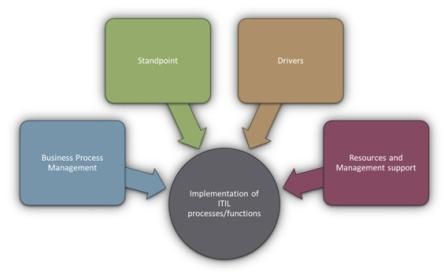 Branimir Valentic
Branimir Valentic
May 21, 2014
How does one describe ITIL implementation? As a book with many questions (at least, the first few chapters of it). The good news is that most of the implementation starts in such a way that there are enough debates to help you to find your own path. The bad news is that there is no cookbook, so implementation guidelines “For dummies…” won’t work.
Is that good or bad? Firstly, that’s the way it is. Secondly, businesses are all different and it’s natural that “one size doesn’t fit all.” In a previous blog post Why ITIL?, I clarified some of the motivational factors. When you are clear about your intention, it’s time to start “the show.” The easiest way would be to begin with the first process, then go to the next one… etc. But, that’s not how it works. You have to be aware that you are impacting the business of the company (IT processes, i.e. services, are closely related to business processes, i.e. services), and therefore thorough preparation needs to be done. Before discussing what needs to be considered before starting the project (yes, usually implementation of ITIL processes and/or functions is done as a project), let’s clarify a few facts that will be helpful to understand the approach.
ITIL is an IT Service Management (ITSM) best practice framework. There are some points (of this definition) that are taken for granted, so I’d like to emphasize two of them here:
Therefore, ITIL is your tool to ITSM and gives you freedom to adapt it to your own situation.
There is one certain way that leads to fiasco – to start implementation of the entire ITIL framework. I know that it sounds like word game, but there are 26 processes and 4 functions in ITIL. To start implementing all (or most) of them… I think it’s not a good idea.
There are many things you need to consider before deciding which part(s) of ITIL you are going to implement. I am giving you a few ideas about some generic issues:
Business Process Management – IT processes have to be aligned with business processes; i.e., IT services have to underpin business services. That means that there is no point in implementing an IT service if the business does not have a need for it. I remember a situation where IT implemented an internal employee portal, which was supposed to integrate all employee-related information and services (e.g., salary data, presence/absence from work, education records and training management, traveling service…etc.), but other departments inside the organization (HR, Finance…) were not properly involved in the project and, consequently, were not motivated to be a part of the service.
Standpoint – It’s very seldom that you are starting from scratch, i.e., that you don’t have any process in place. Maybe they are in chaos, but more than likely you have some processes in place and you need to do something to get them under control, improve them or introduce some additional processes. Before you finish your To-Do list, perform the gap analysis and see how far (or near) to the ITIL recommendations you are. If you have an ITSM tool in place – your “maneuvering space” is usually limited. The reason for that is that tools are customizable to a certain extent (from my experience, level of customization is proportional to the cost of the tool). Don’t forget to consider “pain points” (e.g., those processes which are causing most of the problems, delays, errors…) and “quick-wins” (something that you can implement in a short period of time and show immediate benefit).
Drivers – are you clear on what the drivers are for the implementation? Is it poor customer support emphasized by customer complaints? Or your company is growing and IT (and the services) are gaining in complexity, so you need a “tool” to manage them? Maybe you need better coordination of daily activities in a multi-team environment (and you want to manage the work and not vice-versa)? Whatever the reason is, it’s important that you are clear about it. Namely, it will define your goals, project, resources… etc.
Resources and Management support – when you gain your management’s approval, doors to your resources are open. That’s important because you are, probably, not the only resource in the story. You need some financial resources, other people (either to help you during implementation or as process owners once when you finish), external parties, tools… etc. I had a customer that wanted to consolidate two existing Service Desks and implement several ITIL processes. The idea was excellent, and preparation was done well, but the approach to management was wrong. The implementation project did not take place.
 Figure: Some of the parameters to consider while preparing for implementation
Figure: Some of the parameters to consider while preparing for implementation
Depending on your organization – think about your issues before you approach management to get approval (e.g., if you are part of an international organization, most probably many things are already pre-defined).
Implementing and managing ITIL process(es) is not an easy job. I know that it’s usually quite the contrary. But, if you fail in preparation, the desired domino effect (project preparation, project execution, operational phase, process improvement) will not take place. And, yes, this preparation phase is not technical, but rather tactical, a bit political and even a matter of luck (to ask the right question at the right moment).
You can also use our free Virtual Consultant to help you through the first steps of your ITIL implementation.